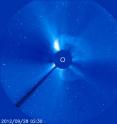NASA sees sun unleash a wide, but benign, CME
The sun erupted with a wide, Earth-directed coronal mass ejection (CME) on Sept. 27, 2012 at 10:25 p.m. EDT. CMEs are a phenomenon that can send billions of tons of solar particles into space that can reach Earth one to three days later, affecting electronic systems in satellites and on the ground. Experimental NASA research models estimate that the CME is traveling at around 700 miles per second and will reach Earth on Sept. 29. CMEs of these speeds are usually benign. In the past, similar CMEs have caused auroras near the poles but have not caused disruption to electrical systems or significantly interfered with GPS or satellite-based communications systems.
The CME is associated with a fairly small solar flare that was measured as C-class, which is third in strength after X- and M-class flares. The flare peaked at 7 p.m. EDT and came from an active region on the sun labeled AR 1577.
Source: NASA/Goddard Space Flight Center
Other sources
- Sun unleashes a wide, but benign, coronal mass ejectionfrom Science DailySat, 29 Sep 2012, 19:30:20 UTC
- NASA sees sun unleash a wide, but benign, CMEfrom PhysorgFri, 28 Sep 2012, 19:30:34 UTC
